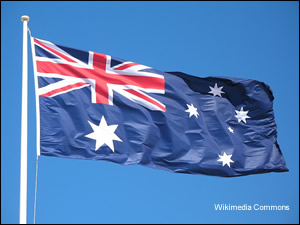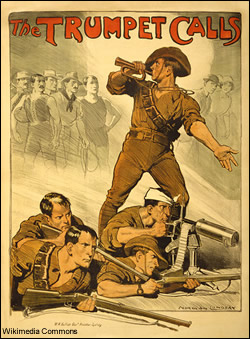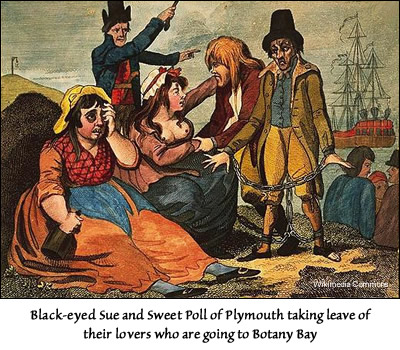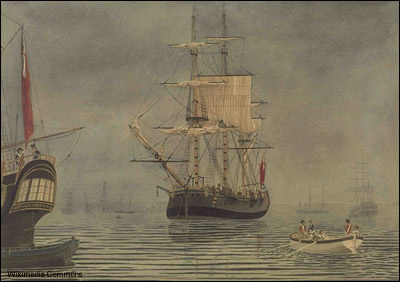There is no country wide system for registering births, marriages and deaths (BMDs) in Australia. Each state keeps its own records. There are no surviving census records apart from the small New South Wales (NSW) census taken in 1841, as details of individuals were destroyed after the statistical information had been extracted. This situation may change in future, as since the 2001 census, Australians have been given the option to allow their data to be published after 99 years.

Although this sounds depressing to someone used to working with English censuses, it is possible to make very good progress with Australian research using alternative sources such as online BMD indexes, electoral rolls and burial records. The BMD indexes in particular are extremely useful, as both parents’ Christian names are usually listed (depending on the date and the state).
Australian BMD certificates are also much more detailed than the English equivalents. Death certificates in particular are a mine of information, as they should include (depending on the state and date) the deceased’s occupation, birthplace, parents’ names, names of spouse(s), names and ages of living children and number of deceased children, and length of time in the colony (assuming that this information was known to the informant).
This site explains in detail what information you can expect to find in Australian BMD certificates:
What you can expect to see on an historical AUS BDM certificate.
State archives are excellent sources of information; some have online indexes and databases, but many records can only be viewed by visiting their offices in person or hiring a local researcher. Most state libraries have a free online ‘Ask a Librarian’ service which can help with family history research, for example by doing electoral roll look-ups.
How to get started
If you know which state your ancestors emigrated to, you can start searching the records in that state (see below).
If you don’t know where they went, these are some possible starting points.
Records covering the whole of Australia
Births, marriages and deaths
Although the separate indexes kept by each State are the most complete, Ancestry now has partial birth, marriage and death indexes for New South Wales, Northern Territory, Queensland, South Australia, Tasmania, Victoria and Western Australia in a single searchable database.
Military service records

Boer War
World War One
National Archives of Australia (click on ‘search now as a guest’) and use the ‘General Search’ to search for service records. A search will bring up brief details of the serviceman, usually with his birthplace, date of birth and next of kin. In most cases, the digitised service record is also online. These can be very detailed, containing details of postings, wounds and illnesses, sometimes names of children, and medals awarded. Some files include correspondence to and from relatives.
The Australian War Memorial site is another excellent site for researching ancestors who fought in various wars, especially WW1. The WW1 records on that site include nominal and embarkation rolls, files relating to prisoners of war and men missing in action, and details of medal citations and awards.
World War Two
Summaries of service records for Australians who served in WW2 can be found here: WW2 Nominal Roll
The details listed usually include place and date of birth, next of kin, and whether taken prisoner.
Similar summaries also appear on the National Archives of Australia site, but not many full service records have been uploaded yet. If you find your ancestor’s details here, the complete service record (usually containing a photo) can be obtained on payment by clicking on ‘Request copy’.
Electoral rolls
Electoral rolls will be found on Ancestry: Australian Electoral Rolls, 1901-1936
Those online cover the following states and dates:-
- Australian Capital Territory: 1928*, 1929-31, 1935*, 1937*, 1943*, 1949*, 1954*
- New South Wales: 1930*, 1931-32, 1933*, 1934-35, 1936-37*, 1943*, 1949*, 1953-54*
- Northern Territory: 1922*, 1928, 1929*, 1930-31, 1934*, 1937*, 1943*, 1949*, 1954*
- Queensland: 1903*, 1905*, 1906, 1908-10, 1912, 1913*, 1914-17, 1919*, 1921*, 1922, 1925*, 1926, 1928-29, 1930*, 1931-32, 1934, 1936-37*, 1943*, 1949*, 1954*
- Tasmania: 1914*, 1915-17, 1919*, 1921, 1922*, 1925, 1928*, 1929-31, 1934, 1936-37*, 1943-44*, 1949*, 1954*
- Victoria: 1856*, 1903*, 1905-06, 1908, 1909*, 1910, 1912-13, 1914*, 1915-18, 1919*, 1920-22, 1924*, 1925-28, 1931*, 1932-35, 1936-37*, 1942-43*, 1949*, 1954*
- Western Australia: 1903*, 1905, 1906*, 1909, 1910-11*, 1912-15, 1916*, 1917-22, 1925*, 1926, 1928-30, 1931*, 1934, 1936-37*, 1943*, 1949*, 1954*
N.B. The asterisked years have been indexed; the others are image-only. South Australia is not included in the database.
The details recorded are name, address and occupation. The index is listed in alphabetical surname order, so it’s possible to find other people of the same surname living at the same address. Address searches are not possible.
The only people included in the electoral roll are obviously those entitled to vote, so children are not included. In the early years, women were not allowed to vote, and even men had to meet property ownership and residency criteria. Women gained the right to vote in the Federal Parliament in 1902, but some states granted them the vote at various dates before that, starting with South Australia in 1894. Aboriginal men and women were not granted the right to vote until 1962.
Cemetery records
The following index covers the whole of Australia, and contains many online records: Australian Cemeteries
This is another useful site – the coverage is more limited, but the index includes transcriptions and photos of headstones: Australian Cemeteries Index
There are many more cemetery indexes online; try searching Google for ‘town_name +cemetery’ (replacing town_name with the name of the town you’re interested in).
Newspapers
Old Australian newspapers can be consulted online at Historic Australian Newspapers, 1803 to 1954, which is part of the Trove site.
Convict ancestors

Prisoners sentenced to transportation were sent from the UK to Australia from 1788 to 1867. A good starting point for researching convict ancestors is Convicts to Australia.
The main resources for researching convicts are transportation registers, convict musters, tickets of leave, certificates of freedom and pardons. After serving part of their sentence, transported convicts could apply for a ticket of leave, which allowed them to seek employment, and even marry, although they were not allowed to leave the district where they lived without permission. After a further period of good behaviour, they could apply for a pardon or a certificate of freedom.
Transportation Registers (Ancestry)
- Australian Convict Transportation Registers – First Fleet, 1787-1788
- Australian Convict Transportation Registers – Second Fleet, 1789-1790
- Australian Convict Transportation Registers – Third Fleet, 1791
- Australian Convict Transportation Registers – Other Fleets & Ships, 1791-1868
Convict musters, tickets of leave, certificates of freedom and pardons
- NSW Tickets of Leave 1810-1875
- Indexes to convict records (NSW) Includes indexes of tickets of leave, certificates of freedom and pardons.
- New South Wales and Tasmania, Australia Convict Musters, 1806-1849 (Ancestry)
- New South Wales and Tasmania, Australia, Convict Pardons and Tickets of Leave, 1834-1859 (Ancestry)
Online convict databases
Tasmania (Van Dieman’s Land): Index to Tasmanian Convicts. Includes many digitised convict records.
Fremantle Prison (Western Australia): Convict Database
Passenger lists

There are numerous passenger list sites online. The following are some of the main ones:-
- UK Incoming Passenger Lists, 1878-1960 (Ancestry)
- Passenger lists leaving UK 1890-1960 (findmypast)
- National Archives of Australia (1921-1950) Click on ‘passenger index’ to search for passenger records. The index lists passengers arriving by ship in Fremantle and other Western Australian ports between January 1921 and 15th January 1950, or arriving at Perth airport between 1944 and 15th January 1950.
New South Wales
- New South Wales, Australia 1828 – 1842: Bounty Immigrants List (Ancestry)
- New South Wales, Australia, Assisted Immigrant Passenger Lists, 1828-1896 (Ancestry)
- New South Wales, Australia, Unassisted Immigrant Passenger Lists, 1826-1922 (Ancestry)
- Passenger lists from 1845-1922: Mariners and Ships in Australian Waters. Not all years have been transcribed yet.
Victoria
- Assisted British Immigration 1839-1871
- Unassisted Inward Passenger Lists to Victoria 1852-1923
- Outward Passengers to Interstate, UK, NZ and Foreign Ports 1852-1896
Queensland
Individual States
New South Wales
Capital: Sydney
Births, marriages and deaths
NSW has a very good free BMD index: NSW Registry of Births, Deaths and Marriages
The index contains:-
- births from 1788 to 1910
- marriages from 1788 to 1960
- deaths from 1788 to 1980
Details listed include the parents’ Christian names. Certificates can be obtained direct from that site, however transcriptions can also be obtained for a much lower price from an authorised transcription agent.
Sands Directories
Another very useful index, includes not only businesses, but also some listings of private residents, mainly in the Sydney area, between 1858 and 1933: Sands Directories: Sydney and New South Wales, Australia, 1858-1933 (Ancestry) NSW State Archives
Online indexes include passenger lists to NSW, divorce index, deceased estates, and many others: The State Archives NSW.
Obituaries
The Ryerson Index is an index of obituaries published in Australian newspapers. The vast majority of obituaries listed on the site are from NSW. It may be possible to obtain a copy of the obituary; click on ‘Requesting a look-up‘.
Rate assessment books (1845-1950)
Assessment Books 1845 – 1950 (City of Sydney)
Cemetery indexes
- Roman Catholic burials in the Sydney area: Catholic Cemeteries Board
- Rookwood cemetery, Sydney (non-conformist burials): Rookwood Independent – Deceased Search
- Rookwood Cemetery, Sydney (Church of England burials*): Anglican and General Cemetery
Victoria
Births, marriages and deaths
Capital: Melbourne
Births, marriages and deaths
births from 1853 to 1908
marriages from 1853 to 1942
deaths from 1853 to 1985
church baptisms, marriages and burials in Victoria from 1836 to 1853.
The site is free to search, but payment is required to view the records found.
Victoria State Archives
Online indexes include divorce, mental health and insolvency records: Public Record Office Victoria Online Catalogue
Cemetery records
Welcome to Necropolis
Wills
Index to Wills, Probate and Administration Records 1841-1925
Queensland
Capital: Brisbane
Births, marriages and deaths
Historical indexes: Births, Marriages and Deaths
The index contains:-
- births from 1829 to 1914
- marriages from 1829 to 1934
- deaths from 1829 to 1964
Cemetery records
Grave location search – Brisbane City Council
Queensland State Archives
Online indexes include divorces, wills and inquests. Queensland State Archives.
Western Australia
Capital: Perth
Births, marriages and deaths
Western Australia Online Indexes
The index contains:-
- births from 1841 to 1932
- marriages from 1841 to 1936
- deaths from 1841 to 1966
More marriages: “Reverse” Marriage Lookup
State Records Office: State Records Office of Western Australia
Western Australian Post Office Directories (1893-1949)
Cemetery records: The Metropolitan Cemeteries Board
South Australia
Capital: Adelaide
Births, marriages and deaths
A partial index of births, marriages and deaths will now be found on Ancestry.
There is no official online BMD index, although applications for certificates can be made to the Births, Deaths and Marriages Registration Office: OCBA – Births deaths and marriages
Several free searchable indexes will be found here, including marriages 1836-1852: Family History South Australia
South Australia State Archives: State Records of South Australia

Northern Territory
Capital: Darwin
Births, marriages and deaths
A partial index of births, marriages and deaths will now be found on Ancestry.
There is no online BMD index, although applications for certificates can be made to the Registry of Births, Deaths and Marriages.
Australian Capital Territory
Capital: Canberra
Births, marriages and deaths
Death index 1930-1973 (in Excel format): ACT Historical Death Index 1930-1973
There is no online birth or marriage index. Applications for certificates can be made to the Registry of Births, Deaths and Births, Deaths and Marriage.
Cemetery records: Canberra’s Public Cemeteries
Tasmania

Capital: Hobart
A partial index of births, marriages and deaths will now be found on Ancestry.
There is no complete BMD index online, but the searchable
Colonial Tasmanian Family Links database provides a starting point.
Mary in Italy
© Mary in Italy 2009